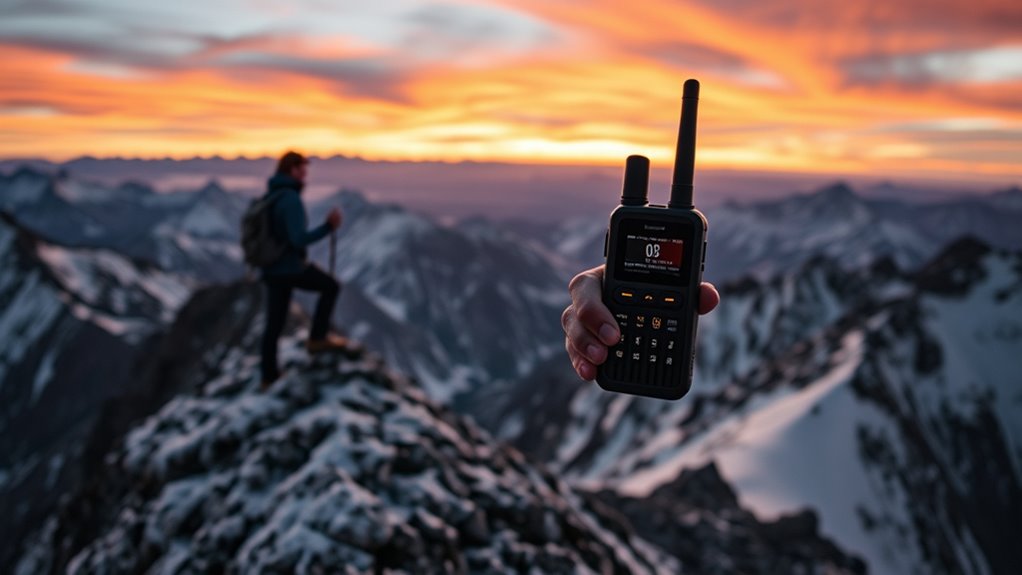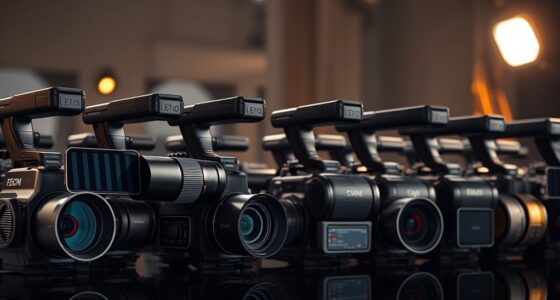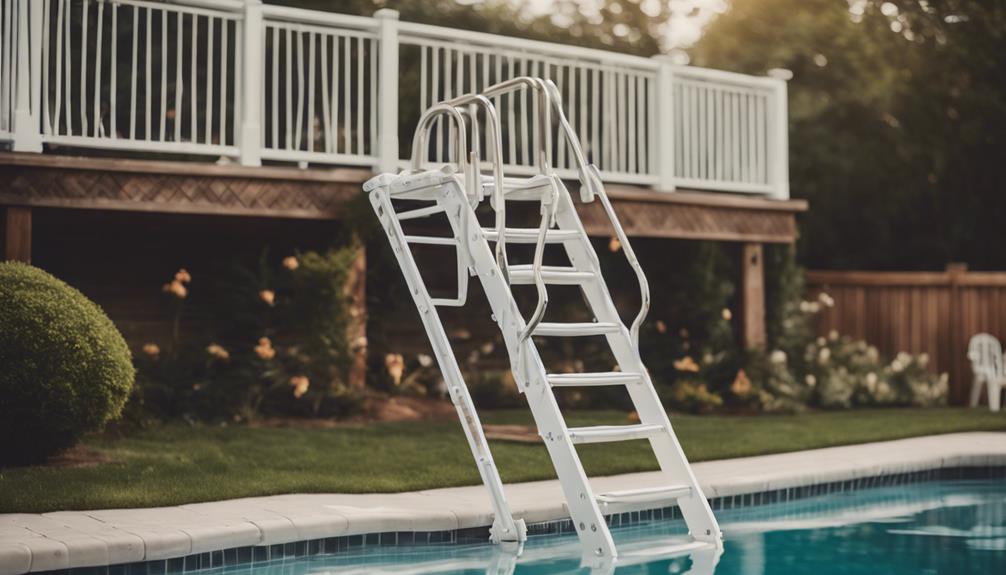If you’re looking for reliable satellite communicators in 2025, I recommend options like Garmin inReach Mini 2, Bivy Stick, and Motorola Defy Satellite Link. These devices offer robust emergency SOS features, global coverage, and long battery life, making them perfect for outdoor adventures and remote work. Many support SMS, email, GPS access, and even group messaging, ensuring you’re never alone. Keep exploring to discover the best choice tailored to your needs.
Key Takeaways
- Look for rugged, waterproof devices like Garmin inReach Mini 2 and Bivy Stick with reliable satellite connectivity and emergency SOS features.
- Consider devices supporting two-way messaging, GPS tracking, and group communication for comprehensive emergency response.
- Prioritize units with extended battery life and multiple charging options for long-duration remote use.
- Ensure compatibility with your devices and coverage area, especially Iridium or Globalstar networks, for near-global reach.
- Evaluate subscription plans, ease of use, and quick activation features to ensure reliable emergency communication in 2025.
ZOLEO Satellite Communicator, Global SMS & Email Emergency SOS
If you’re heading into remote areas where cell coverage is unreliable, the ZOLEO Satellite Communicator is a top choice because it keeps you connected with global SMS and email capabilities over the Iridium satellite network. It works via cellular or Wi-Fi, depending on what’s available, and provides a dedicated SMS number and email address so contacts can reach you directly. In emergencies, it sends GPS-enabled SOS alerts to a 24/7 monitoring center, ensuring help arrives quickly. Its durability and long battery life—over 200 hours—make it reliable in tough environments. Plus, features like check-ins and optional rescue coverage boost your safety during remote adventures.
Best For: outdoor enthusiasts, travelers, and professionals venturing into remote areas needing reliable satellite communication and emergency safety features.
Pros:
- Provides global SMS and email messaging via Iridium satellite network, ensuring connectivity off-grid.
- Offers emergency SOS alerts with GPS location sharing to a 24/7 monitoring center for rapid assistance.
- Built with rugged IP68-rated durability and boasts over 200 hours of battery life for extended use in harsh environments.
Cons:
- Requires a paid service plan to access satellite connectivity and messaging features.
- May be more expensive than standard communication devices due to specialized satellite capabilities.
- Additional optional features like travel rescue coverage come at extra cost.
Midland LXT600VP3 FRS Walkie Talkies (2-Pack)
The Midland LXT600VP3 FRS Walkie Talkies (2-Pack) are an excellent choice for outdoor enthusiasts and families who need reliable long-range communication, especially in areas where cell service may be unavailable. These compact, lightweight radios support up to 30 miles in open terrain, making them perfect for outdoor adventures, events, or emergencies. They feature 36 channels with privacy codes, NOAA Weather Scan + Alert for severe weather updates, and include essential accessories like belt clips and chargers. While effective up to 1 mile in city settings, their true strength lies in unobstructed environments, offering dependable communication when it matters most.
Best For: outdoor enthusiasts, families, and professionals seeking reliable long-range communication in open or obstructed environments.
Pros:
- Supports up to 30 miles of communication in open terrain, ideal for outdoor adventures and large areas
- Features 36 channels with privacy codes and NOAA Weather Scan + Alert for safety and interference-free use
- Compact, lightweight, and durable design with included accessories like belt clips and chargers
Cons:
- Effective range diminishes to about 1 mile in city environments with obstructions
- Battery performance can vary; weak batteries may cause transmission issues despite full battery indicators
- Some users report occasional signal loss or limited performance with multiple units in complex settings
ZOLEO Satellite Communicator: Global SMS & Email, Emergency SOS, GPS Accessory
Designed for adventurers and remote workers alike, the ZOLEO Satellite Communicator keeps you connected beyond cell coverage by offering reliable global SMS and email messaging through the Iridium satellite network. It connects via cellular or Wi-Fi using the lowest-cost available network, with a service plan required. You get a dedicated SMS number and email, so contacts can reach you off-grid. The device features emergency SOS alerts with GPS location, access to Medical Assist, and unlimited check-ins, including GPS sharing. Built rugged with over 200 hours of battery life, ZOLEO is perfect for staying safe and connected in remote environments.
Best For: outdoor enthusiasts, remote workers, and travelers who need reliable global communication and safety features in challenging environments.
Pros:
- Enables global SMS and email messaging via satellite, extending connectivity beyond cell coverage
- Offers emergency SOS with GPS location sharing and Medical Assist access for enhanced safety
- Rugged IP68 design with over 200 hours of battery life ensures durability and reliable performance in harsh conditions
Cons:
- Requires an active service plan for satellite connectivity, incurring additional costs
- Dependent on Iridium satellite network, which may have limited bandwidth during high usage periods
- Features like GPS sharing and check-ins may require familiarity with device operation and app integration
Motorola Defy Satellite Link Rugged GPS Communicator
For outdoor enthusiasts who need reliable satellite communication in rugged conditions, the Motorola Defy Satellite Link stands out as an affordable and durable option. It turns smartphones into satellite-enabled devices via Bluetooth, compatible with iOS 14+ and Android 10+. Its rugged design (3.4 x 2.5 x 0.5 inches, 2.5 ounces) ensures durability off-grid. It offers global SMS, emergency SOS alerts, and two-way messaging, with plans starting at just $4.99/month. While setup can be straightforward, some users face pairing issues and message length limits (35 characters). Still, many find its quick satellite connection and low cost make it a reliable backup for remote adventures.
Best For: outdoor enthusiasts seeking an affordable, rugged satellite communication device for emergency and casual off-grid messaging.
Pros:
- Compact, durable design suitable for rugged outdoor conditions
- Affordable plans starting at $4.99/month with reliable satellite connection
- Easy to use for basic check-ins, emergency SOS, and coordinate sharing
Cons:
- Limited message length of about 35 characters, restricting communication
- Occasional pairing issues and app usability frustrations reported by users
- No dedicated phone number, which can limit incoming message options and spam filtering
Garmin inReach Mini 2 Satellite Communicator
If you need a compact satellite communicator that’s perfect for outdoor adventurers, the Garmin inReach Mini 2 stands out with its lightweight design and reliable two-way messaging. Measuring just 2.04 x 3.9 x 1.03 inches and weighing only 3.5 ounces, it’s easy to carry on any trip. The device offers interactive SOS, real-time location sharing, and navigation features like TracBack routing. It syncs seamlessly with the Garmin Explore app for trip planning and mapping. While activation can take a couple of days and messaging may be slow, its small size, long battery life, and safety features make it a dependable tool for remote adventures.
Best For: outdoor enthusiasts, hikers, and adventurers seeking a reliable, compact satellite communication device for remote areas.
Pros:
- Small, lightweight design enhances portability and ease of use
- Supports two-way messaging, interactive SOS, and real-time location sharing for safety
- Long battery life (up to 14 days) ideal for extended trips
Cons:
- Messaging can be slow, taking 5-20 minutes to send or receive messages
- Activation process may take up to two days, delaying immediate use
- Lacks built-in maps, relying only on waypoint and position display, which may be disappointing for navigation needs
Garmin inReach Messenger Satellite Communicator
The Garmin inReach Messenger Satellite Communicator stands out as an excellent choice for outdoor enthusiasts who need reliable, two-way communication in remote areas. Weighing just 4 ounces, it features a rugged design with a clear display, supporting global messaging, GPS location sharing, and interactive SOS alerts. Its seamless switch between Wi-Fi, cellular, and satellite networks ensures consistent connectivity, even in challenging weather or dense forests. The device offers safety features like weather forecasts and TracBack routing, plus long battery life of up to 28 days in power-saving mode. It’s perfect for hiking, fishing, or remote travel, providing peace of mind wherever adventure takes you.
Best For: outdoor enthusiasts, hikers, and remote travelers who require reliable two-way communication and safety features in challenging environments.
Pros:
- Compact, lightweight, and rugged design ideal for outdoor use
- Seamless switching between Wi-Fi, cellular, and satellite networks for reliable connectivity
- Long battery life up to 28 days in power-saving mode, ideal for extended trips
Cons:
- Requires an active satellite subscription, which can add ongoing costs
- Small display size may limit ease of reading messages or details
- Battery life may decrease with heavy or frequent usage, necessitating careful power management
Emergency Weather Radio with 5 Power Options, Portable AM/FM/SW/NOAA Weather Radio, Cellphone Charger, Camping Flashlight, Reading Lamp, SOS Alarm
Emergency weather radios with multiple power options are essential tools for anyone who wants reliable communication and safety during disasters. I’ve found that having five charging methods—solar, hand crank, USB, AAA batteries, and AC—ensures continuous operation even when power is out. This portable device offers multi-band reception—AM, FM, SW, NOAA weather alerts—with clear sound and a loud SOS alarm for emergencies. Its built-in 5000mAh rechargeable battery powers a camping flashlight, reading lamp, and cellphone charger. Compact and lightweight, it’s perfect for indoor or outdoor use. Overall, it’s a versatile, dependable survival tool that keeps you informed and connected when you need it most.
Best For: preppers, campers, and families seeking reliable, multi-functional emergency communication and power solutions during disasters.
Pros:
- Multiple charging options (solar, hand crank, USB, AAA, AC) ensure continuous power supply during outages.
- Clear multi-band reception (AM/FM/SW/NOAA) with loud alerts keeps you informed and safe.
- Built-in 5000mAh rechargeable battery powers flashlight, reading lamp, and cellphone charging for convenience.
Cons:
- Some users report button instability and circuit issues affecting durability.
- Limited SW reception in certain models or difficulty tuning for shortwave signals.
- Slightly larger size and lightweight design may still pose portability considerations for some users.
Spot X with Bluetooth 2-Way Satellite Messenger
For outdoor enthusiasts who want dependable communication in remote areas, the Spot X with Bluetooth 2-Way Satellite Messenger offers a practical solution. It provides SOS protection, GPS tracking, and the ability to connect via Bluetooth to smartphones, making it easy to stay in touch with family or search and rescue teams. Weighing just 7 ounces, it operates independently with its own US mobile number for messaging. The device uses the Globalstar Satellite Network for worldwide coverage, but performance can suffer in dense cellular or 5G zones. While reliable off-grid, interference issues and small controls mean careful handling are necessary for ideal use.
Best For: outdoor enthusiasts and adventurers needing reliable satellite communication, SOS protection, and GPS tracking in remote areas with minimal cellular coverage.
Pros:
- Provides SOS emergency signaling and GPS tracking for safety in remote environments
- Connects via Bluetooth to smartphones for easy messaging and coordination
- Operates independently with its own US mobile number, enabling standalone messaging
Cons:
- Performance can be significantly limited or unreliable in dense cellular or 5G zones due to interference
- Small screen and keypad may be difficult to operate, especially in challenging conditions
- Signal interference and orientation sensitivity can cause message delays, device shutdowns, or SOS cancellation issues
Garmin inReach Messenger Plus Satellite Communicator
If you’re heading into remote areas without cell coverage, the Garmin inReach Messenger Plus stands out as a reliable choice thanks to its seamless shift between Wi-Fi, cellular, and satellite networks. It offers two-way text, photo, and voice messaging, along with emergency SOS support via Garmin Response. The device pairs with smartphones and Garmin watches for easy control, and boasts impressive battery life—up to 25 days in tracking mode. Its rugged, water-resistant design ensures durability in harsh conditions. While a subscription is required for full features, its safety and connectivity options make it a dependable tool for outdoor adventures and emergencies alike.
Best For: outdoor enthusiasts, hikers, and adventurers who need reliable satellite communication and emergency safety features in remote areas without cell coverage.
Pros:
- Seamless switching between Wi-Fi, cellular, and satellite networks ensures reliable connectivity.
- Long battery life of up to 25 days in tracking mode supports extended outdoor activities.
- Rugged, water-resistant (IPX7) design offers durability in harsh environmental conditions.
Cons:
- Requires an active subscription for messaging and SOS features, adding ongoing costs.
- Small display and limited navigation buttons may hinder ease of use for some users.
- Full functionality depends on contacts having the Garmin app installed; standalone messaging is limited.
ACR Bivy Stick Satellite Communicator
The ACR Bivy Stick Satellite Communicator stands out as an ideal choice for outdoor enthusiasts who need reliable global connectivity off the grid. It offers Iridium satellite coverage for two-way SMS, email, GPS tracking, offline maps, SOS alerts, weather updates, and location sharing through the Bivy app. With a dedicated phone number and email, you can stay connected without cell service. Its waterproof design, Bluetooth, Wi-Fi, and easy-to-use buttons make it practical in rugged environments. GroupTrack allows messaging with up to 12 people, and the emergency SOS feature ensures help is always within reach. It’s a versatile device built for safety and peace of mind during remote adventures.
Best For: outdoor adventurers, remote travelers, and groups needing reliable off-grid communication and safety features.
Pros:
- Offers global Iridium satellite coverage for reliable communication worldwide.
- Includes safety features like SOS alerts, GroupTrack messaging, and live GPS tracking.
- Waterproof, durable design with offline maps and easy-to-use interface for rugged environments.
Cons:
- App complexity and setup may require some learning before use.
- Battery life and charging issues have been reported by some users.
- Subscription plans can be costly, especially for unlimited use.
Walkie Talkies 10 Pack Long Range Rechargeable 2-Way Radio
When quick, reliable communication is essential in outdoor activities, emergencies, or large-scale events, the Walkie Talkies 10 Pack Long Range Rechargeable 2-Way Radio stands out as an excellent choice. These radios offer 16 preprogrammed channels, with an optional cable for customization, and operate on UHF frequencies supporting 0.6 to 3.5 miles of range depending on terrain. With a 1500mAh battery, they deliver 8-12 hours of use, and each includes a charging dock for convenience. Praised for clear sound and durability, these radios are perfect for business, safety, or recreation. They’re lightweight, feature a built-in torch, and are FCC authorized, ensuring reliable, long-range communication when it matters most.
Best For: outdoor enthusiasts, event coordinators, and small business teams seeking reliable long-range communication.
Pros:
- Clear sound quality with reliable long-distance coverage up to 3.5 miles in open terrain
- Rechargeable batteries with 8-12 hours of use per charge and included charging docks for convenience
- Durable, lightweight design with additional features like built-in torch and privacy codes for secure communication
Cons:
- Some users experience static or minor audio issues on certain units
- Short earpiece cables can disconnect or fray over time, requiring replacement
- Antenna modifications may be necessary for optimal range in certain environments
ACR Bivy Stick MESH Satellite Communicator
For outdoor enthusiasts, rescue teams, and anyone operating in remote areas, the ACR Bivy Stick MESH stands out thanks to its dual communication modes that combine LoRa mesh networking with global Iridium satellite coverage. This setup guarantees reliable connectivity even in the most challenging environments. Messaging is fast—device-to-device within seconds—and supports group chats and location sharing. Rugged, waterproof, and built for tough conditions, it’s ideal for outdoor adventures and emergencies. With SOS features, a long-lasting battery, and seamless relay capabilities, the Bivy Stick keeps you connected and safe, no matter where your journey takes you.
Best For: outdoor enthusiasts, rescue teams, and remote area operators needing reliable, rugged, and quick satellite and mesh communication.
Pros:
- Combines LoRa mesh networking with global Iridium satellite coverage for versatile connectivity.
- Supports fast device-to-device messaging, group chats, and real-time location sharing.
- Rugged, waterproof design with emergency SOS features and long-lasting battery life.
Cons:
- Slightly larger and heavier than some basic communication devices, which may be a consideration for lightweight packing.
- Requires compatible iOS or Android devices for full functionality, possibly limiting users without smartphones.
- The cost may be higher compared to simpler satellite communicators lacking mesh capabilities.
Wearable4U Garmin inReach Mini 2 Satellite Communicator with Power Pack Bundle
If you’re heading into remote areas where cell service is unreliable, the Wearable4U Garmin inReach Mini 2 Satellite Communicator with Power Pack Bundle stands out as an essential tool. Its compact, lightweight design makes it easy to carry, while features like two-way messaging, interactive SOS, and navigation ensure safety and connectivity. The device syncs with the Garmin Explore app for trip planning and mapping, and pairs with Garmin wearables for quick messaging and SOS triggers. With a battery life of up to 14 days and included charging accessories, it’s perfect for outdoor adventures like trekking or hunting, providing peace of mind in the most isolated locations.
Best For: outdoor enthusiasts, adventurers, and travelers venturing into remote areas with limited or no cellular coverage who need reliable communication and safety features.
Pros:
- Compact, lightweight design ideal for portability during outdoor activities
- Extended battery life of up to 14 days ensures reliable operation on long trips
- Features like two-way messaging, interactive SOS, and navigation enhance safety and connectivity
Cons:
- Shipping restrictions due to hazardous battery materials may limit availability in some regions
- Battery life can drain quickly during extended use if not properly managed or tested beforehand
- Some users have reported minor issues with device durability and customer support responsiveness
Wearable4U Garmin inReach Messenger Satellite Communicator
The Wearable4U Garmin inReach Messenger stands out as an ideal choice for adventurers and remote travelers who need reliable two-way communication in areas without cell coverage. Its compact, rugged design is lightweight, weighing just over a pound, and offers up to 28 days of battery life in tracking mode. You can send and receive messages via the Garmin Messenger app, with options for group chats and preset check-ins. Voice commands add convenience, and its internal rechargeable battery guarantees ongoing use. While some users report connectivity issues in dense forests, overall, it’s praised for its ease of use, helpful features, and suitability for long outdoor excursions.
Best For: outdoor adventurers and remote travelers seeking reliable two-way satellite communication in areas without cell coverage.
Pros:
- Compact, lightweight, and rugged design suitable for outdoor use
- Up to 28 days of battery life in 10-minute tracking mode
- Easy messaging via Garmin Messenger app with group chat and preset check-ins
Cons:
- Connectivity issues reported in dense forests or limited sky view areas
- Some users experience incompatibility with the included power pack and charging accessories
- Frequent recharging needed during extended outdoor trips
Factors to Consider When Choosing Satellite Communicators for Emergencies

When choosing a satellite communicator for emergencies, I always consider factors like coverage and network type to guarantee reliable connectivity where I go. Battery life and durability are also key, since I need a device that can last through tough conditions. Finally, I look at ease of use, emergency features, and how well it connects with other devices to make sure it’s practical in real emergencies.
Coverage and Network Type
Choosing the right satellite communicator depends heavily on the network type and coverage area it offers. Different networks like Iridium, Globalstar, or LoRa serve various needs. Iridium provides near-global coverage, including polar regions, making it perfect for remote or extreme environments. Globalstar, while offering good coverage in North America and parts of the world, doesn’t reach polar areas. LoRa mesh networks enable short-distance device-to-device communication, ideal for supplementing satellite links in certain situations. Coverage quality can vary based on satellite constellation density, location, and environmental obstructions like dense forests or urban canyons. Your choice should align with your specific needs—whether you require worldwide coverage, low latency, or two-way communication. Understanding these differences obfuscates you select a communicator suited for your emergency scenarios.
Battery Life Durability
Long battery life is essential for satellite communicators used in emergencies, as it guarantees the device stays operational during extended periods without access to power. Devices with over 200 hours of battery life support continuous check-ins, GPS tracking, and emergency alerts without frequent recharging. Rechargeable batteries with multiple power options, like solar, hand crank, or USB, boost durability by offering alternative charging methods in power-scarce environments. Proper battery management is crucial—fully charging before trips and monitoring battery levels via indicators or app controls helps guarantee reliable operation. Keep in mind, extreme temperatures and heavy usage can degrade battery performance, so selecting a device with high-capacity batteries and efficient power consumption is vital for long-term durability and dependable communication in emergencies.
Ease of Use
A satellite communicator’s ease of use can make all the difference in an emergency situation. A device with an intuitive interface, featuring simple buttons and clear instructions, allows for quick operation when every second counts. A dedicated display with status indicators helps me easily monitor battery life, signal strength, and message delivery without guesswork. User-friendly features like preset messages, one-button SOS activation, and minimal setup boost reliability, especially in stressful moments. Seamless compatibility with smartphones or apps ensures I can quickly pair and access essential functions without confusion. Clear, concise instructions and straightforward onboarding make it possible to operate the device effectively, even if I’m not technically inclined. Ultimately, simplicity and clarity are key to ensuring I stay connected and safe during emergencies.
Emergency Features
When emergencies strike, having reliable safety features on a satellite communicator can make all the difference. I look for devices with SOS alerts that connect instantly to 24/7 monitoring centers, guaranteeing help is just a button away. GPS location sharing is vital, as it allows rescue teams to locate me quickly and accurately. Some communicators offer interactive SOS options, enabling direct communication with emergency responders rather than just signals. Additional safety features like automatic weather alerts, medical assistance access, and customizable check-in messages boost my confidence in a device. A dedicated emergency button or alarm is indispensable for immediate distress signals, providing peace of mind during critical moments. These features guarantee I’m prepared and can act swiftly when every second counts.
Compatibility and Connectivity
Choosing a satellite communicator that works seamlessly with your devices can substantially improve your emergency preparedness. Make certain it’s compatible with your smartphone’s operating system, whether iOS 14+ or Android 10+. Check if the device supports multiple connectivity options like Bluetooth, Wi-Fi, and cellular networks, giving you versatility in different scenarios. It’s also essential that the device can switch smoothly between satellite, cellular, and Wi-Fi networks to ensure reliable communication in remote areas. Additionally, confirm compatibility with apps or platforms you already use for messaging, GPS sharing, or emergency alerts. Finally, consider the satellite network coverage—whether Iridium, Globalstar, or LoRa—to match your travel destinations and guarantee consistent connectivity when it matters most.
Cost and Subscription Plans
Considering the variety of subscription plans available for satellite communicators, it’s essential to evaluate costs carefully to find the best fit for your needs and budget. Plans usually start around $4.99 per month, with higher tiers offering more message limits and features like GPS sharing or email. Many devices require ongoing subscription fees, ranging from $5 to over $60 monthly, depending on usage and provider. Some plans provide discounts for annual commitments, which can considerably lower overall costs. Keep in mind that data usage varies based on message length and additional features, impacting your expenses. Comparing plan features and costs is vital to ensure you select a service that meets your emergency communication needs without breaking the bank.
Frequently Asked Questions
How Does Satellite Coverage Vary in Remote or Urban Areas?
Satellite coverage can vary considerably between remote and urban areas. In remote regions, coverage might be limited or less reliable due to fewer satellites overhead, making communication tricky. Conversely, urban areas usually have better coverage thanks to multiple satellite signals bouncing off buildings and infrastructure. I always check coverage maps before heading into remote spots, knowing that urban areas tend to offer more consistent satellite connectivity.
What Is the Battery Life Expectancy During Extended Emergencies?
During extended emergencies, I’ve seen satellite communicators last up to 10 days on a single charge, like a marathon runner pacing steady. Most models feature rechargeable batteries with lifespans of about 500 to 1,000 charge cycles, meaning reliable performance for weeks. I always carry a portable solar panel; it’s like having a personal energy farm, ensuring I stay connected when it matters most.
Are These Devices Waterproof or Weather-Resistant for Harsh Conditions?
Yes, most satellite communicators are designed to be waterproof or weather-resistant, so I can rely on them even in harsh conditions. I always check the IP rating before purchasing, aiming for at least IP67 or higher. This means they can handle rain, splashes, and even brief submersion. Knowing I have a device that withstands extreme weather gives me peace of mind during outdoor adventures or emergencies.
Can These Communicators Operate Independently Without Cell Service?
Yes, these satellite communicators can operate independently without cell service. I’ve used mine in remote areas where cellular signals don’t reach, and it worked perfectly. They connect directly to satellites, ensuring reliable communication even far from civilization. You don’t need any local network, just a clear view of the sky. This independence makes them essential for emergencies, outdoor adventures, or remote work where traditional cell service isn’t available.
How Secure Is the Data Transmission During Emergency Use?
The security of data transmission during emergency use is incredibly tight, basically impenetrable. I trust that satellite communicators use advanced encryption, making it almost impossible for hackers to intercept sensitive info. While no system can be 100% foolproof, these devices prioritize privacy and security, so I feel confident sharing critical details when it matters most. Rest assured, your data stays safe when every second counts.
Conclusion
Choosing the right satellite communicator is like having a lifeboat in a storm—you hope you never need it, but you’re glad it’s there when you do. I remember hiking remote trails and realizing how vital reliable communication can be. With the right device, you’re not just surviving an emergency — you’re steering through it confidently. Trust me, investing in one of these tools could be the difference between getting lost and making it home safely.
























